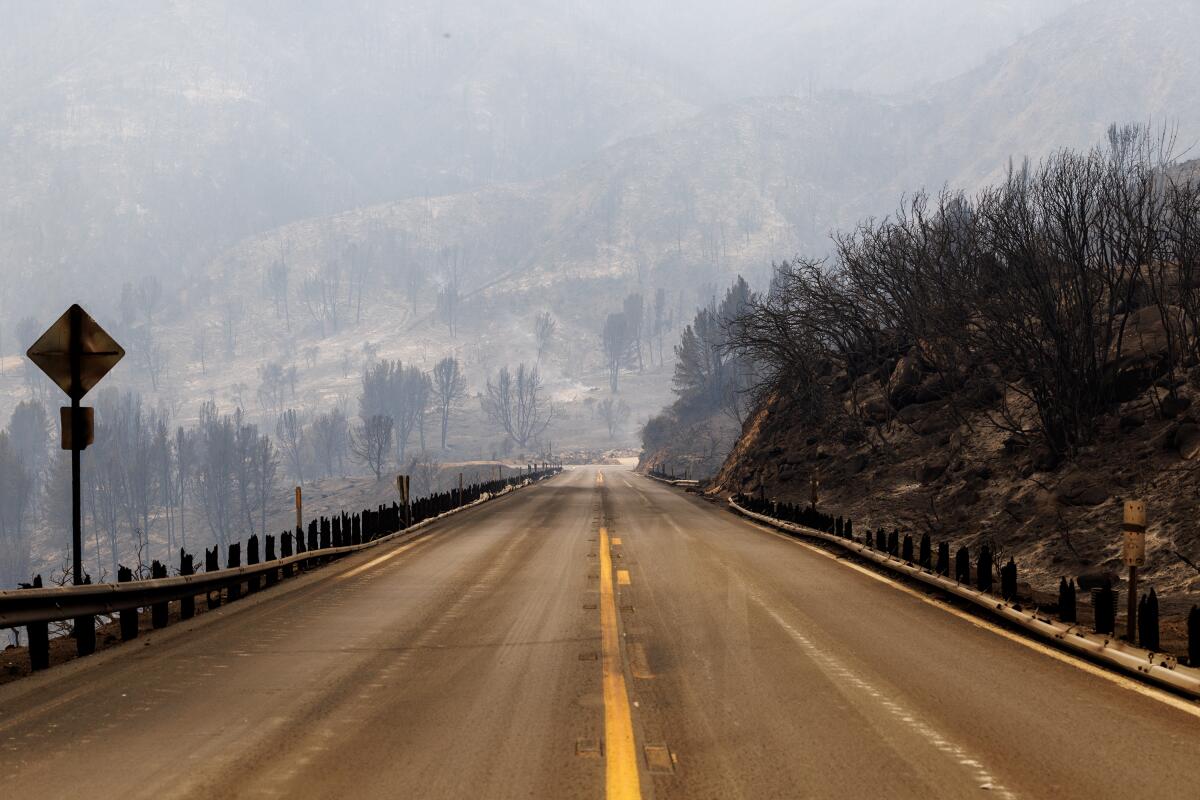Firefighting crews in Southern California continued to battle out-of-control wildfires Monday that have scorched thousands of acres in Los Angeles and San Bernardino counties and forced residents to flee their homes amid record-breaking heat.
The Line fire in San Bernardino had grown to 20,553 acres in four days and was 3% contained Monday morning, according to the California Department of Forestry and Fire Protection. In L.A. County, the Bridge fire quickly chewed up 800 acres Sunday and had Angeles Forest visitors and some local residents fleeing the flames. The fire was 0% contained Monday morning.
The Line fire forced mandatory evacuations over the weekend in mountain communities that included Running Springs, Arrowbear Lake, Forest Falls and Mountain Home Village. Evacuation warnings were also issued for Lake Arrowhead, Cedar Glen, Crestline, Valley of Enchantment, Angelus Oaks and Seven Oaks.
More than 36,300 structures were threatened by the fire late Sunday, including single and multifamily homes. Three firefighters have been injured; more than 1,800 personnel have been assigned to tackle the flames.
Over the weekend, thunderstorms and lightning limited firefighters’ ability to dump flame retardants and water on the fire, said National Weather Service meteorologist Dave Munyan with the San Diego office. By 6:30 p.m. Saturday, 282 lightning strikes were recorded in Highland and Big Bear, with 3,337 other lightning flashes that stayed in the clouds, the weather service reported.
“Because they’re trying to fight the fires on some steep terrain, it’s almost impossible for them to utilize ground attack,” Munyan said.
Crews also were having to battle the fire amid severe heat. Temperatures ranged from the upper 80s to over 100 degrees in the fire area.
“The weather is definitely not cooperating for [firefighters] today,” Munyan said. But by mid-evening Sunday, he added: “Things are pretty much quieting down, for the most part. … The good news is, without a lot of storm activity, perhaps aviation-related tactics can be resumed.”
The heat wave bearing down on the Southland was not expected to break until Tuesday, with an excessive heat warning in effect until Monday night. Los Angeles County and surrounding areas were under a red flag warning as temperatures reached more than 100 degrees in some areas. The combination of high heat and humidity brought a chance of thunderstorms across the mountains of Los Angeles, San Bernardino and Ventura counties, and the Antelope and San Gabriel valleys.
On Saturday, firefighters were using hand lines, hoses and fixed-wing aircraft to fight the fire, which started Thursday evening and grew rapidly that night as temperatures climbed to 110 degrees.
The fire leaped from 3,800 acres early Saturday in the city of Highland to 7,122 acres by the evening as it spread northeast into the San Bernardino Mountains toward Running Springs and Arrowbear Lake.
A man waters the roof to protect his house as the Line fire burns in the San Bernardino Mountain foothills, forcing evacuations on Saturday.
(Apu Gomes / Getty Images)
Gov. Gavin Newsom proclaimed a state of emergency in San Bernardino County on Saturday night and announced that federal funds would help reimburse the cost of suppressing the fire.
“I thank President Biden for his swift approval of support for the work of our firefighters and first responders battling this fire and protecting local communities,” Newsom said in a statement. “It’s critical that residents in the impacted areas remain vigilant and prepare to evacuate immediately if called for by local authorities.”
The National Weather Service Los Angeles said Saturday weather conditions were exacerbating the Line fire into a “dangerous situation.” Outflow winds from pyrocumulonimbus clouds — thunderstorms that form above sources of intense heat, such as wildfires — were pushing the flames around, the weather service said in a post on the social platform X.
“It’s burning out of control,” said David Cruz, spokesman for the San Bernardino National Forest.
Running Springs, a community of about 4,600 residents, is a major gateway to the popular tourist destinations of Lake Arrowhead and Big Bear. About 735 people live in Arrowbear Lake. On Saturday, residents jammed exit routes as they scrambled to comply with mandatory evacuation orders issued by the San Bernardino County Sheriff’s Department. Images from a live video feed posted on social media showed a long line of cars slowly moving down a single mountain lane.
“There’s a giant traffic jam,” Cruz said.
The so-called front route to Big Bear Lake — Highway 330 from Highland Avenue to Highway 18 in Running Springs, and Highway 18 between Running Springs and the Big Bear Lake dam — remained closed Sunday night. Highway 38 was shut down at Bryant Street, with an additional closure at Angelus Oaks.
Other areas under evacuation orders, which are issued when conditions are immediately dangerous and life-threatening, include:
- The area from Calle Del Rio to Highway 38, including Greenspot Road North
- All underdeveloped land east of Highway 330 to Summertrail Place and north of Highland Avenue
- The areas of Running Springs east of Highway 330 and south of Highway 18
- The area east of Orchard Road to Cloverhill Drive from Highland Avenue north to the foothills
- North of Highland Avenue and east of Palm Avenue to Highway 330
- Garnett Street east to the 138 and Mill Creek north to the foothills
Evacuation shelters were open at the San Bernardino County Fairgrounds, at 14800 7th St. in Victorville, and the Jessie Turner Community Center in Fontana at 15556 Summit Ave.

Terrain is burned on both sides of Highway 330 from the Line fire in Highland.
(Gina Ferazzi / Los Angeles Times)
Meanwhile, the Bridge fire broke out in the Angeles National Forest north of Glendora on Sunday afternoon, expanding quickly to 800 acres and prompting evacuation orders for Camp Williams Resort and an adjacent river community.
Fire crews were battling the fire by air and by land. Dana Dierkes, public affairs officer for the Angeles National Forest, said aircraft were dropping water and fire retardant on the blaze, which started for unknown reasons about 2:40 p.m. Sunday on East Fork Road near Glendora Mountain Road in the San Gabriel Canyon.
Temperatures remained high Sunday, with some of the firefighter base camps experiencing 105 degree temperatures. In Palm Springs, temperatures hit 111.
Times staff writer Joseph Serna contributed to this report.




